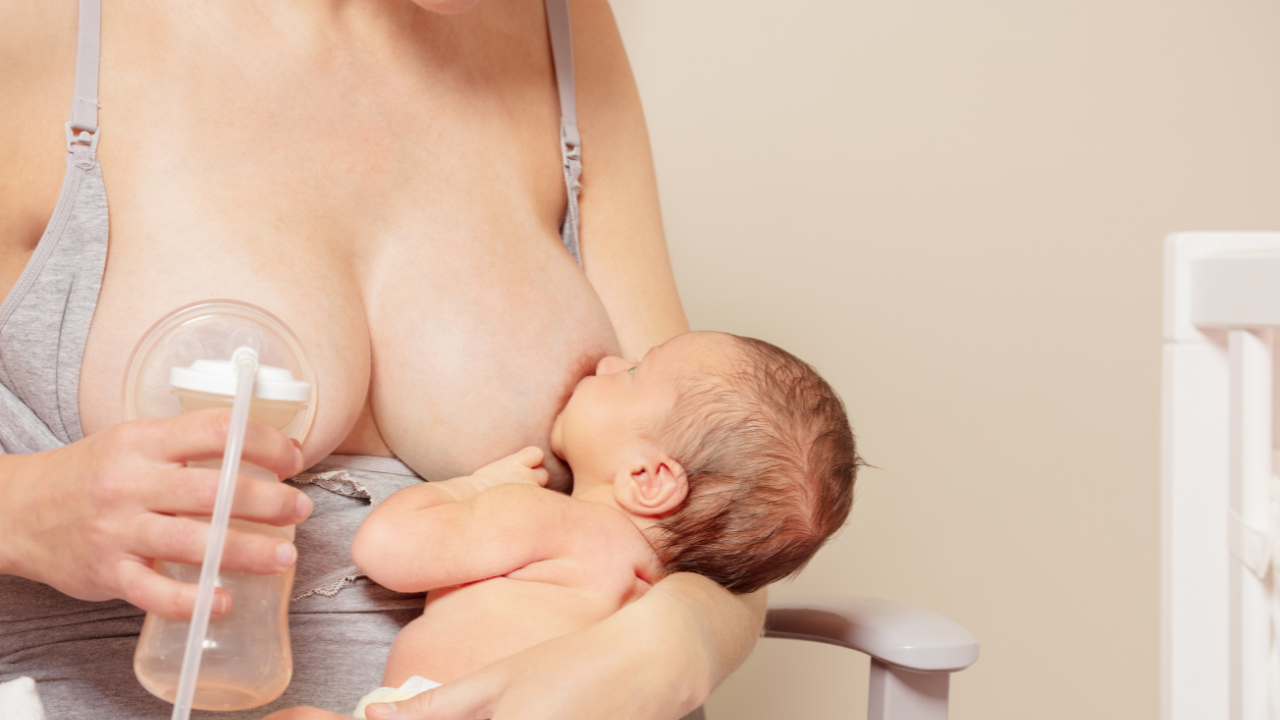If you’re breastfeeding and suddenly feel like your chest has turned into two hot, heavy bowling balls, you’re not alone—and you’re not doing anything wrong. Breast engorgement is totally normal in the early days of breastfeeding, especially when your milk first comes in. For most moms, it passes quickly and can be eased just by feeding your baby often and making sure they’re latched well. That said, when engorgement gets intense, painful, or persistent, there are things you can do to feel better fast. Let’s break down what’s happening and what you can do about it.
What Is Breast Engorgement?
Breast engorgement happens when your breasts become overly full of milk, fluids, and blood. They swell up, feel rock-hard, and often ache or throb. This usually shows up around days 2 to 5 after your baby is born—right when your milk starts to come in.
There are two kinds of engorged breasts:
- Physiological engorgement is the normal fullness that comes with milk production ramping up.
- Pathological engorgement is when things go overboard—your breasts are painfully full, the skin feels tight and shiny, and your baby may struggle to latch.
Some moms even feel swelling or lumps in or around their armpits. That’s normal—extra lymph fluid or accessory breast tissue can extend that far.
Why Does Breast Engorgement Happen?
Some engorgement is completely normal—your body is adjusting milk production to meet your baby’s needs, especially in the first few days. But when milk isn’t being removed often or effectively enough, engorgement can become more intense and painful. That could be because:
- Your baby isn’t latching properly.
- You’re not breastfeeding often enough.
- You’re supplementing with formula, so your breasts aren’t getting emptied.
- You had a cesarean section, and breastfeeding was delayed.
- You’re producing more milk than your baby needs (an oversupply of milk).
- Your baby is sleeping long stretches or skipping feedings—especially at night.
- You received a lot of IV fluids during labor, which can contribute to swelling.
Basically, if the milk keeps coming in but doesn’t go out, things back up fast.
How Common Is Breast Engorgement?
You’re definitely not the only one going through this. Research shows that around 50% to 70% of breastfeeding mothers experience engorgement, especially in the early days. First-time moms, moms who had c-sections, and those not exclusively breastfeeding are more likely to deal with it.
Good news: many moms find it easier with their second or third child. That’s because mature milk tends to come in faster with each baby, and your body gets more efficient at the process.
What Does It Feel Like?
It’s more than just a full feeling. Symptoms include:
- Swollen, firm, heavy breasts
- Pain or tenderness
- Skin that feels hot or looks shiny
- Flattened nipples, making it hard for the baby to latch
- A slight fever or flu-like symptoms (be careful—this could also signal mastitis)
- Slightly lumpy or hard spots
- Swollen lymph nodes in the armpits
What Happens If You Ignore It?
Ignoring engorgement can lead to bigger problems:
- Blocked ducts: Milk gets stuck, creating hard, painful lumps.
- Mastitis: An infection that causes redness, fever, and even more pain.
- Cracked nipples: From poor latching due to the engorged breast shape.
- Early weaning: Many moms give up breastfeeding because of the pain and frustration.
How to Get Relief Fast
Good news—engorgement is treatable and usually temporary. Here’s what helps:
1. Nurse often and effectively
Feed your baby frequently (every 2–3 hours) and make sure they’re latched well.
2. Express milk for relief
If your baby can’t latch, hand express or pump just enough to soften the breast. Don’t fully empty—you might stimulate even more production.
3. Use cold and warm compresses
- Warm compress before feeding to help milk flow
- Cold compress or chilled cabbage leaves after feeding to reduce swelling

4. Try gentle breast massage
Massage in circular motions toward the nipple to encourage drainage. Breast compression during feeds can also help drain the breast more efficiently.

5. Reverse pressure softening
Reverse pressure softening (RPS) is a technique used to reduce swelling around the areola so your baby can latch on more easily. When breasts are engorged, the areola becomes too firm for the baby to get a good grip. To do RPS, use clean fingers to apply steady, gentle pressure around the base of the nipple for 1–3 minutes. You’re essentially pushing the excess fluid back into the breast tissue temporarily so the nipple becomes more protruded and pliable. This can help your baby latch effectively, drain milk better, and break the cycle of worsening engorgement. Try this just before feeding or pumping.
“By day three, I thought my boobs were going to explode. My baby couldn’t latch, and I was crying from the pain. A lactation consultant showed me how to express just a little milk and use reverse pressure. Total game-changer. Within two days, everything felt manageable again.”
— Lisa, mom of two
6. Relax during breastfeeding
Your body needs oxytocin to let milk flow, and that hormone kicks in better when you’re calm. Breathe, listen to music, or do whatever helps you relax.
7. Wear a comfortable bra
A well-fitting, supportive nursing bra can make a big difference when you’re engorged. Look for a bra without underwires and one that’s made of soft, breathable fabric. The goal is to support your breasts without compressing them, which can worsen pain or even lead to clogged ducts. Avoid tight bands or cups that leave marks on your skin. A bra with drop-down cups or easy access for nursing is also helpful—you want as few obstacles as possible between you and quick relief. Some moms even go braless for short periods to reduce pressure. Do what makes you feel supported but not squished.
8. Take safe pain relief
Over-the-counter options like ibuprofen are generally safe while breastfeeding, but check with your doctor.
9. Try dangle feeding
Dangle feeding is a breastfeeding position where you lean over your baby so your breast hangs downward into their mouth. Gravity helps with milk flow, and this position can encourage better drainage of milk ducts—especially helpful when you’re engorged or dealing with blocked ducts. It may also help if your baby is having trouble latching due to breast fullness. While it might not be the most comfortable position for every feed, it can be a great tool to add to your rotation, especially when you need relief fast.

What If You Have Flat or Inverted Nipples?
Engorgement can make already flat or inverted nipples harder to latch. Try reverse pressure softening or a nipple shield (short-term) and work with a lactation consultant to find the best latch technique.
How to Prevent Engorged Breasts
You might not be able to avoid it 100%, but you can lower your risk:
- Start breastfeeding within the first hour after birth if possible.
- Breastfeed on demand—not by a strict schedule.
- Avoid unnecessary bottles or pacifiers in the early days.
- Get help with latch and position from a lactation consultant.
- Don’t skip night feeds—this is key to avoiding back-up.
- Consider co-sleeping (safely) to make night feeds easier.
- Gradually wean when you’re ready—abrupt weaning can trigger engorgement.
- If you miss a feed, express a little milk manually to stay comfortable.
When to Call for Help
If your symptoms don’t improve within 24–48 hours—or if you develop a high fever, chills, or red streaks on your breast—call your doctor or lactation consultant. You could be developing an infection like mastitis, which may need antibiotics.
Final Thoughts
Engorgement is rough—but it’s also temporary. The key is to act early, feed frequently, and ask for help when you need it. Your body is learning, your baby is learning, and it will get easier.
If you’re feeling overwhelmed, talk to a lactation consultant or your healthcare provider. There’s no shame in needing support—and every drop of effort you’re putting in counts.
Need help?
Contact a certified lactation consultant (IBCLC) or speak to your midwife or GP. Join the La Leche League International online breastfeeding support group.
References
- Cleveland Clinic. Breast Engorgement: Causes, Complications & Treatment.
- Academy of Breastfeeding Medicine. Clinical Protocol #20: Engorgement.
- La Leche League International. Breast Engorgement Resources.
- NHS UK. Breastfeeding Problems: Breast Pain.
- Cochrane Review. Treatments for Breast Engorgement During Lactation.
- Zakarija-Grković, I., & Stewart, F. (2020). Treatments for breast engorgement during lactation. Cochrane Database of Systematic Reviews.
- Upadhye, J.J., et al. Prevalence of Breast Problems Among Lactating Mothers. PMC.
- Herald Open Access. Study on Breast Engorgement Among Lactating Mothers.
- Lactation Education Resources. Engorgement: Lactation Consultant Guide.
- MedSchool UCLA. Overcoming Common Breastfeeding Challenges.
- Breastfeeding.Support. Engorgement Relief When Milk Won’t Flow.


